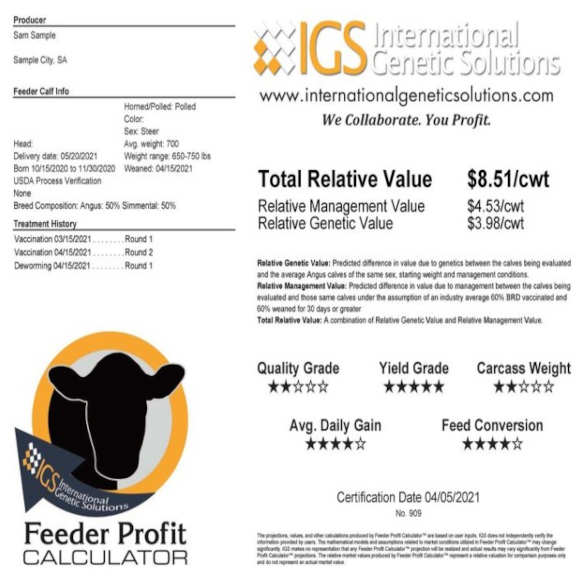By Phil Durst
Now there is a tool that can objectively determine value, not only helping producers understand what buyers are willing to pay for, but also how to improve calf value.

Example certificate from the IGS Feeder Profit Calculator
With the new calf crop on the ground, a cow-calf producer often looks over them with pride, thinking about their potential to be great beef animals. Indeed, these new calves are the beginning of the product that the producer will sell and the promise of the profits to come. Pride and hope are mixed in the sight of calves following their mothers across the pasture.
Do feedlot operators share the same level of hope and expectation that the cow-calf farmer has? Each person has a perspective in the business of producing beef at a profit. Can those perspectives be shared?
Indeed, the cow-calf producer who sells feeder cattle must learn more about how buyers evaluate and value calves if calf production is to be profitable according to Michigan State University Extension beef educators. While the price paid on sale day is a report card on calf value, the wisest will seek to understand, long before that day, how their calves rate relative to those of other producers.
A tool available to all calf producers is the Feeder Profit Calculator (FPC) offered by International Genetic Solutions (IGS). This tool, acting as a third-party, unbiased evaluator that is available at no cost, provides a value differential ($/cwt.) for your calves relative to the average angus calf that will sell. The benefit in having that relative value is not just in seeing how buyers will value your calves compared to others, but in providing you with a benchmark to improve the value of your calves.
That relative value differential is based on genetics and management. The management factors are practices that have a value to the buyer, by reducing potential for death or disease in the feedlot, and by increasing the likelihood of good rates of gain. The resulting values are data driven. For the genetic side, IGS relies on its extensive access to the expected progeny differences (EPD) information on bulls across many breeds. When you enter sire information for dams in your cow herd, maternal side genetics are also included. The FPC works equally well for straightbred, crossbred, or composite cattle.
On the management side, factors considered include days weaned before sale and vaccination protocols. The FPC assumes that 60% of calves will be weaned at least 30 days and that the same percentage will be double vaccinated for Bovine Respiratory Disease (BRD). The FPC only considers factors that lead to biological outcomes, and not market distinctions that you may choose to capitalize on. For example, if your cattle are labeled “natural” or “organic,” those are not biological factors and are not included in the calculations.
Nor does the FPC consider factors that do not add value for the buyer. Therefore, if you implant calves, the calculator does not register an increase in value, though you may sell heavier calves as a result of implanting.
Each of these groups of factors will have a value differential relative to the average as the base. The range of values in practice is from around -$10 to +$7/cwt. for relative management value, and from around -$5 to +$5/cwt. for relative genetic value. The values of the two sets of factors are added together to yield the Relative Feeder Profit.
The heavier the calves are, the lower the price differential. This is because a heavier, and therefore, older calf has less risk of going to a feedlot; the unknown value of management and genetics are lower at an older age. While the same genetics and same management of younger calves always produces greater price differential on a per hundredweight (cwt.) basis, there will be less difference in the overall premium for the animals.
Calf producers who participate will receive a certificate that outlines the value and rates calves with a number of stars (out of five possible) on a variety of measures by the percentile of calves that participate in the program. For example, calves are awarded stars for carcass quality grade, carcass weight potential, average daily gain, feed efficiency, and feed conversion.
Certificates also highlight information including the breed makeup, weight range and the treatment history of the calves (vaccinations, deworming, etc.) supplied by the producer. Electronic certificates can be sent to potential buyers ahead of sale date. At a feeder calf sale in my area, cow-calf producers who use the FPC post the certificate on their pens at the saleyard so that buyers can see the third-party rating of those calves.
To begin, cow-calf producers can follow the link at www.internationalgeneticsolutions.com, or download the app onto your smartphone. The needed information can be entered relatively quickly and, as usual, the better the information you enter, the more reliable the results will be.
It is important to remember that this tool has its place and its limitations. Many cow-calf producers retain heifers for cow replacements. Therefore, your breeding program should not only emphasize the feedlot and carcass value of calves, but also the maternal value for the ones who will be retained.
In today’s market conditions, where average doesn’t pay the bills, cow-calf producers need to continually sharpen their management to gain prices that are higher than average. The IGS Feeder Profit Calculator provides a tool to help producers continually push toward the higher end of the market.
Source : msu.edu